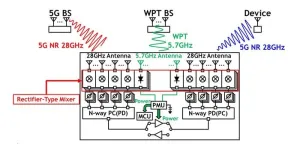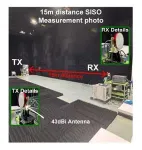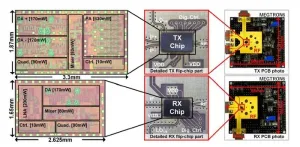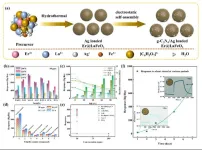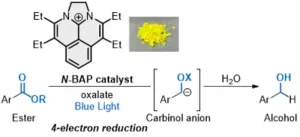(Press-News.org) A recently developed wirelessly powered 5G relay could accelerate the development of smart factories, report scientists from Tokyo Tech. By adopting a lower operating frequency for wireless power transfer, the proposed relay design solves many of the current limitations, including range and efficiency. In turn, this allows for a more versatile and widespread arrangement of sensors and transceivers in industrial settings.
One of the hallmarks of the Information Age is the transformation of industries towards a greater flow of information. This can be readily seen in high-tech factories and warehouses, where wireless sensors and transceivers are installed in robots, production machinery, and automatic vehicles. In many cases, 5G networks are used to orchestrate operations and communications between these devices.
To avoid relying on cumbersome wired power sources, sensors and transceivers can be energized remotely via wireless power transfer (WPT). However, one problem with conventional WPT designs is that they operate at 24 GHz. At such high frequencies, transmission beams must be extremely narrow to avoid energy losses. Moreover, power can only be transmitted if there is a clear line of sight between the WPT system and the target device. Since 5G relays are often used to extend the range of 5G base stations, WPT needs to reach even further, which is yet another challenge for 24 GHz systems.
To address the limitations of WPT, a research team from Tokyo Institute of Technology has come up with a clever solution. In a recent study, whose results have been presented in the 2024 IEEE Symposium on VLSI Technology & Circuits, they developed a novel 5G relay that can be powered wirelessly at a lower frequency of 5.7 GHz (as shown in Figure 1). “By using 5.7 GHz as the WPT frequency, we can get wider coverage than conventional 24 GHz WPT systems, enabling a wider range of devices to operate simultaneously,” explains senior author and Associate Professor Atsushi Shirane.
The proposed wirelessly powered relay is meant to act as an intermediary receiver and transmitter of 5G signals, which can originate from a 5G base station or wireless devices. The key innovation of this system is the use of a rectifier-type mixer, which performs 4th-order subharmonic mixing while also generating DC power.
Notably, the mixer uses the received 5.7 GHz WPT signal as a local signal. With this local signal, together with multiplying circuits, phase shifters, and a power combiner, the mixer ‘down-converts’ a received 28 GHz signal into a 5.2 GHz signal. Then, this 5.2 GHz signal is internally amplified, up-converted to 28 GHz through the inverse process, and retransmitted to its intended destination.
To drive these internal amplifiers, the proposed system first rectifies the 5.7 GHz WPT signal to produce DC power, which is managed by a dedicated power management unit. This ingenious approach offers several advantages, as Shirane highlights: “Since the 5.7 GHz WPT signal has less path loss than the 24 GHz signal, more power can be obtained from a rectifier. In addition, the 5.7 GHz rectifier has a lower loss than 24 GHz rectifiers and can operate at a higher power conversion efficiency.” Finally, this proposed circuit design allows for selecting the transistor size, bias voltage, matching, cutoff frequency of the filter, and load to maximize conversion efficiency and conversion gain simultaneously.
Through several experiments, the research team showcased the capabilities of their proposed relay (refer Figure 2). Occupying only a 1.5 mm by 0.77 mm chip using standard CMOS technology, a single chip can output a high power of 6.45 mW at an input power of 10.7 dBm. Notably, multiple chips could be combined to achieve a higher power output. Considering its many advantages, the proposed 5.7 GHz WPT system could thus greatly contribute to the development of smart factories.
Stay tuned for further advances in this exciting field as we dive deeper into the Information Age!
###
About Tokyo Institute of Technology
Tokyo Tech stands at the forefront of research and higher education as the leading university for science and technology in Japan. Tokyo Tech researchers excel in fields ranging from materials science to biology, computer science, and physics. Founded in 1881, Tokyo Tech hosts over 10,000 undergraduate and graduate students per year, who develop into scientific leaders and some of the most sought-after engineers in industry. Embodying the Japanese philosophy of “monotsukuri,” meaning “technical ingenuity and innovation,” the Tokyo Tech community strives to contribute to society through high-impact research.
https://www.titech.ac.jp/english/
END
A new D-band CMOS transceiver chipset with 56 GHz signal-chain bandwidth achieves the highest transmission speed of 640 Gbps for a wireless device realized with integrated circuits, as reported by researchers from Tokyo Tech and National Institute of Information and Communications Technology. The proposed chipset is highly promising for the next generation of wireless systems.
To achieve faster speeds and handle increasing data traffic, wireless systems are operating in higher millimeter-wave frequency bands. Current high-band 5G systems offer speeds as high as 10 Gbps and operate in frequency bands between 24–47 GHz. The next generation ...
Peer-reviewed – Qualitative study - Humans
A new study has provided an in-depth look into the rising trend of disposable vape use among young people in the UK.
The research, led by the University of East Anglia, reveals that young people see smoking and vaping as interchangeable, but are far more aware of the potential harms of vaping than they are of the dangers of smoking.
The findings also suggest that banning disposable vape products or increasing their prices could lead young people to revert to smoking tobacco.
Many of the young people questioned also believed that ...
Atlanta, Ga.—Eczema, a skin inflammatory disease that causes dry, itchy and inflamed skin, affects millions worldwide. Eczema is associated with an altered skin microbiome and higher colonization by Staphylococcus aureus. The study, led at New York Medical by postdoctoral fellow Anish R. Maskey, Ph.D., focuses on the natural compound berberine and its impact on eczema exacerbated by S. aureus. The findings, presented at ASM Microbe, shed light on berberine’s ability to inhibit S. aureus colonization and alleviate eczema symptoms without adverse effects.
Current ...
A data-driven intervention that engaged communities to rapidly deploy evidence-based practices to reduce opioid-related overdose deaths – such as increasing naloxone distribution and enhancing access to medication for opioid use disorder – did not result in a statistically significant reduction in opioid-related overdose death rates during the evaluation period, according to results from the National Institutes of Health’s HEALing (Helping to End Addiction Long-Term) Communities Study. Researchers identified the COVID-19 pandemic and increased prevalence ...
Atlanta, GA – New research has shed light on the effects of protein-rich diets on the gut microbiome and overall health. Despite the increasing protein intake in Western diets, especially among athletes and individuals with obesity, the fate of undigested protein and its impact on human health remains largely unknown. A new study, presented at ASM Microbe, explores how excess undigested protein in the colon can be fermented to produce beneficial metabolites, such as short-chain fatty acids (SCFAs), or lead to the production of harmful metabolites like ammonia and sulfides, which are linked to gastrointestinal disorders and other health issues.
The research team conducted a series of experiments ...
Highlights:
Mouse studies suggest a link between the gut microbiome and neurodegenerative diseases, but the pathways remain unclear.
New study reports distinct bacterial and metabolite profile in patients with Alzheimer’s disease and other neurodegenerative diseases.
The study flagged the metabolite DHPS as a possible missing link in our understanding of how gut microbes influence NDDs through sulfur metabolism pathways.
Atlanta, Ga.—Neurodegenerative diseases (NDDs), which have no known cures and elusive causes, result in irreversible damage to the brain and nervous system. Research into these diseases typically focuses on the brain, but mouse ...
TLS are accumulations of lymphoid cells that share similar cellular compartments, organization, and function as secondary lymphoid organs. Importantly, the presence of these structures in inflamed salivary glands associated with active disease, increased autoantibody production, and malignancy risk.
“To treat patients effectively, comprehensive understanding of the salivary gland microenvironment is needed”, said Saba Nayar, “but current profiling efforts often struggle to capture high-plex 'omics data while preserving the spatial architecture of the tissue.”
To ...
The 16-week Plants for Joints trial investigated the effects of a multidisciplinary lifestyle intervention in people with RA, as compared to usual care. The intervention was based on a whole-food, plant-based diet – alongside physical activity and stress management. Previous reports showed this intervention significantly reduced the 28-joint disease activity score (DAS28) compared to usual care alone.2,3 To expand on this, the researchers wanted to determine the long-term effectiveness of the intervention, specifically with ...
The volatile of isoamyl alcohol released from the stored wheat increased with the storage extending, making it one of the potential biomarkers for the early-stage of wheat mildew. Currently, there is a scarcity of chemiresistors for isoamyl alcohol detection, which suffer from low sensitivity. The team of material scientists led by Professor Chao Zhang reported that LaFeO3-based sensing materials demonstrated remarkable sensitivity for isoamyl alcohol (DOI: 10.1039/D3TA05718F, 10.1007/s11666-024-01740-4). However, it’s essential to note that there is still potential for lowering the optimal operating temperature and enhancing moisture ...
The sweet smell of strawberries and other fruits is thanks to a chemical compound called ester, which is also found in many fats and polyesters. The ubiquitous compound can be broken down to produce desirable alcohols and other chemicals for use across industries including pharmaceuticals and cosmetics, but the process can be costly, both financially and in terms of the environment.
Now, a team of researchers with the National Institutes of Natural Sciences (NINS) in Japan has developed a novel approach using light as an energy ...
